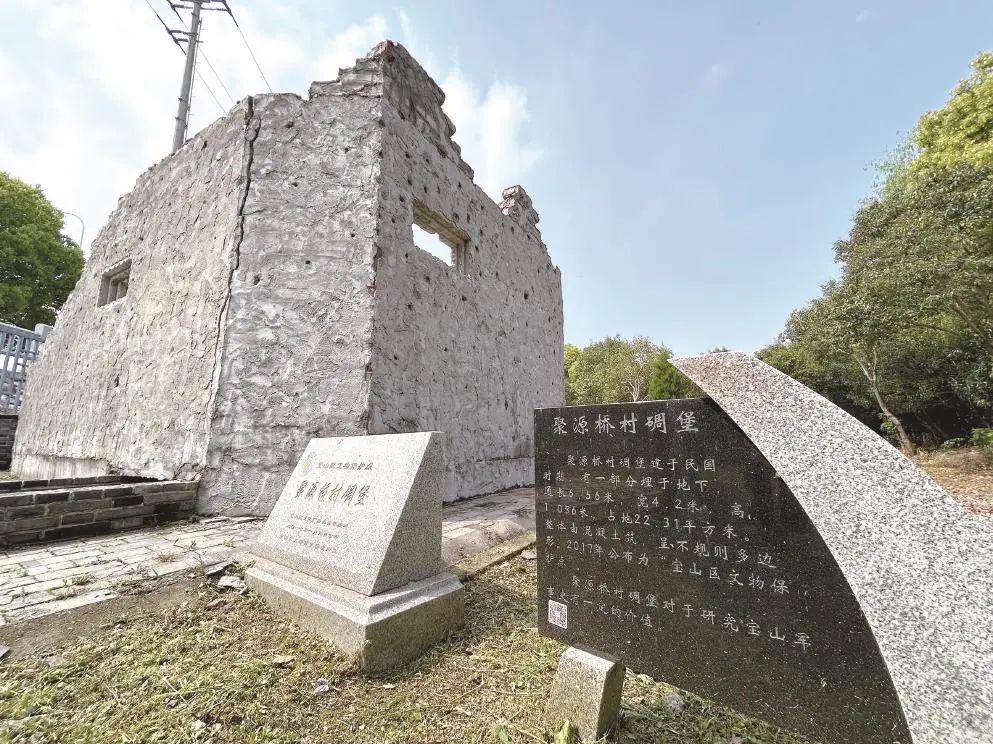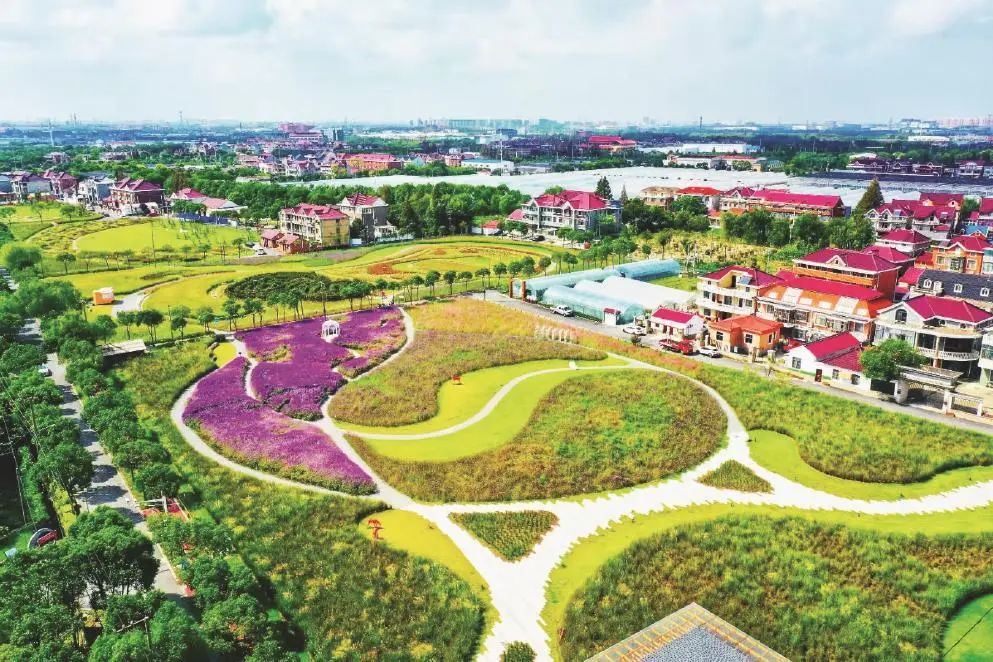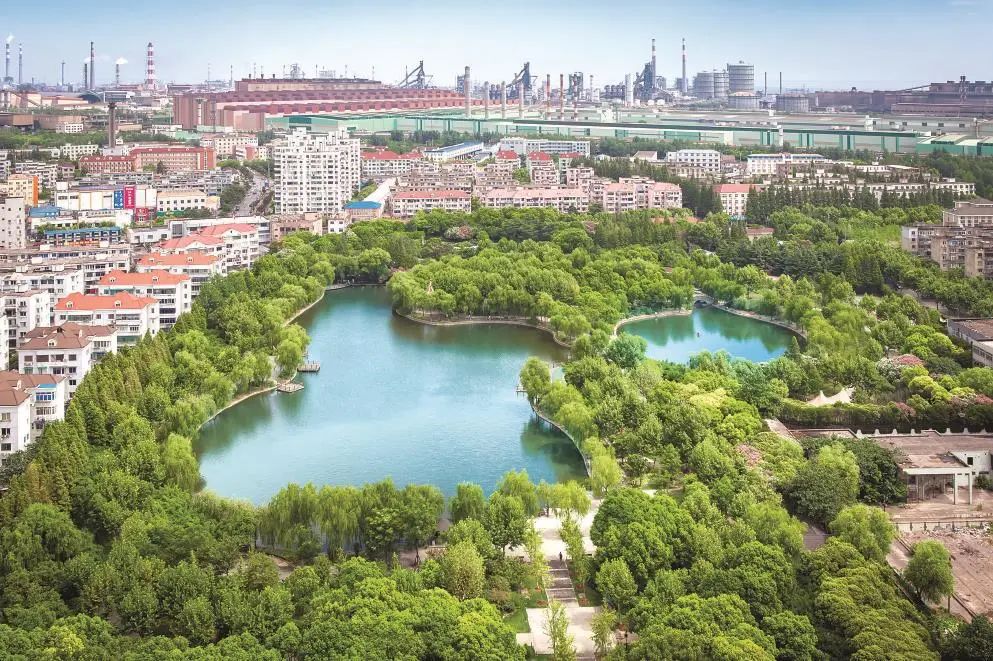1,200-Year-Old Yuepu Town in Baoshan Undergoes Incredible Transformation
Yuepu Town in Baoshan District, situated near the Yangtze River estuary, has a profound history.
As the wheels of the times roll forward, how will this turbulent town write a new chapter in its pioneering efforts? Its attempts at maximizing land use efficiency and transforming into a flower hub may offer insights into its future trajectory.

Remains of a blockhouse in Juyuanqiao Village (Photo by journalist Wang Jiayi)
Efficient land use
Yuepu Town, once renowned for its steel manufacturing, is undergoing drastic transformation and upgrading.
To facilitate interconnected north-south development, Yuepu Town has actively promoted the reallocation of land resources to high-efficiency, high-output, and high-tech enterprises by rectifying and phasing out those with high input, high energy consumption, high pollution, and low efficiency. Last year, Yuepu Town repurposed six inefficient plots and put 66 mu (44,000 square meters) of industrial development space into use. This year, it will continue its efforts to rectify low-end industries and low-efficiency enterprises with a focus on transforming Yueyang Industrial Park.
The transformation is not about radical change, but rather tapping into new arenas with development potential such as low carbon, new materials, and intelligent equipment manufacturing while building on traditional competitive industries.
Take low carbon as an example. Iron and steel enterprises have a substantial need for carbon emission reduction. There exists a plethora of application scenarios in hundreds of production and processing processes such as reduction of dust pollution during manufacturing and alignment with “zero-waste city” initiatives, presenting numerous opportunities for innovation.

Such opportunities have led to the establishment of the Yangtze River Bay Carbon Science and Technology Park. Located in Yuepu Industrial Park, it is a green and low-carbon industrial park built by Yuepu Town by leveraging local resources. By attracting universities, research institutions, and leading low-carbon enterprises, Yuepu Town has accelerated the research, development, and commercialization of low-carbon technologies, promoted the gathering of green and low-carbon industries in Yuepu Industrial Park, and created innovative low-carbon development clusters, thus driving regional industrial transformation and upgrading.
According to the Secretary of the Yuepu Town Party Committee, industrial transformation must “focus on one sector and penetrate throughout the entire industrial chain”. For the low-carbon industry, this means prioritizing key areas and promoting investment in green carbon, green energy, and green electricity sectors to transform the industrial chain and supply chain.
The establishment of China’s first boron nitride nanotube (BNNT) production line in Yuepu is a testament to this strategy. According to the person in charge, BNNTs have diverse applications in emerging industries such as aerospace, advanced manufacturing, and biomedicine. Globally, only four companies have successfully developed the technology for the mass production of BNNTs, and their production capacities remain limited, reaching only the kilogram level. This has raised the price of the materials and hindered the further development and application of BNNTs. In the future, the production line in Yuepu is expected to drive large-scale industrial applications of advanced manufacturing and other sectors in the surrounding area and promote the upgrading of related industrial chains and supply chains.
Strategic moves like this exemplify Yuepu Town’s approach to regional transformation: leveraging targeted initiatives to drive comprehensive development.
From steel hub to flower valley
In the latest round of rural revitalization, Yuepu Town has embraced a bold vision, transforming from a steel hub into a flower valley.
In the past, Yuepu Town was synonymous with factory buildings, tall chimneys, and bustling cargo ships and trucks. Out of the town’s area of 45 square kilometers, 25 are occupied by Baowu Group’s facilities. This is the reality that Yuepu Town has to face.
To reverse people’s impressions, Yuepu Town launched a flower festival. The first Yuepu Flower Festival took place in May 2018, when flowers were in full bloom. This event marked the beginning of Yuepu Town’s active efforts to develop field cultivation of flowers and explore a flower industry management model of “leading enterprises + cooperatives + farmers”. The once scattered private plots were thereby merged and managed in a centralized manner, transforming into a large-scale ecological flower plantation in Yueshi Village.
The flower festival has become an annual tradition, cultivating what is known as the “beauty economy”. This has boosted the confidence of Yuepu Town, which proposed to create a “flower town”, with a dedicated flower land reserve.
As a result, innovative companies like Flower Breath and Ai Meng Duo Rou started operations in the area and explored new business forms such as “rural live broadcast”. Ai Meng Duo Rou, a succulent plant venture broadcasting from Juyuanqiao Village in Yuepu, has become a well-known online store. When loyal customers follow the navigation to the offline store, they often find it hard to believe that this charming “succulent world” was once an abandoned processing factory.
Repurposing idle resources such as warehouses, factories, and homesteads has been key to fostering the beauty economy in the “flower town”. Yuepu Town has endeavored to integrate resources and build a platform for cooperation with enterprises. It has also established special subsidy funds to support vacant rental property, housing safety assessment, and interior decoration. Up to now, a total of 32 unused farmhouses in Yuepu Town have been transformed into corporate offices, talent apartments, B&Bs, and restaurants, with 29 companies moving into the countryside.

One notable example is B the Place, a B&B founded by three young entrepreneurs. This quality countryside B&B offers leisure spaces like coffee shops and seasonal delicacies, along with rural-themed scripted role-playing games inspired by the revolutionary culture of the region.
According to local officials, collaboration is crucial for promoting the beauty economy. Yueshi Village, Juyuanqiao Village, and Shenjiaqiao Village, connected by the Gujing River in Yuepu, have been listed as Shanghai's rural revitalization demonstration villages. This has created an industrial layout resembling the Chinese character “丰”, facilitating the integrated development of the three villages. In addition, the “Vibrant Yuepu with Dynamic Countryside” tour route has been listed among quality tour routes for 2023 beautiful village leisure travel in China (spring edition) by the Ministry of Agriculture and Rural Affairs.

Yuepu Town turns from a steel hub into a flower valley during rural revitalization
Yuepu Town’s transformation from a steel hub into a flower valley is both surprising and reasonable, as it aligns perfectly with the region’s development needs.
A community of governance

Yuepu Park and neighborhoods in the past

Verdant Yuepu Park today
For Yuepu Town, a former factory area, primary-level governance has been a significant challenge. Many retired residents are accustomed to the old model of work unit trusteeship, making it difficult to engage them and restore the vitality of the community.
A prime example of successful governance is Yueyuan Pocket Park, a joint project between Yuepu Town and Baosteel’s Department of Energy and Environmental Protection. The site of the park was initially a temporary dumping ground for construction waste. Its proximity to three residential compounds of Baolianhu, Feicuiyuan, and Xinyue Fudi made it an unregulated “public land”.
Who should manage the area and how? With these questions, Yuepu Town has strengthened primary-level governance through Party building by encouraging regional Party building partner organizations to take on the responsibilities. Baosteel’s Department of Energy and Environmental Protection has become actively involved as a result. This collaboration successfully transformed the waste dumping area into an urban open space of approximately 8,300 square meters, including surrounding green spaces. During the design process, residents nearby actively contributed valuable suggestions, ensuring that the park met everyone’s expectations.
In addition to addressing long-standing issues, Yuepu Town has formalized these efforts by establishing mechanisms. In September last year, it launched the first community welfare foundation in Baoshan District. Jointly funded by nine philanthropic enterprises within the jurisdiction, this foundation supports community welfare projects aiming at meeting public needs and enhancing governance. The first batch of ten projects covers various areas, including the installation of elevators, community development, care for elderly people living alone, and protection of minors.
According to the person in charge, primary-level governance often involves addressing personalized problems. In Yuepu Town, older residential communities where retired workers live and newer ones with younger residents often have different needs. The community welfare foundation helps avoid a one-size-fits-all approach in community services by supporting characteristic projects. This ensures that limited resources are allocated where they are most needed. Furthermore, the foundation fosters a community of social governance in which everyone fulfills their responsibilities and shares in the benefits by engaging residents in project approval, discussion, voting, and implementation processes.


宝山汇APP

上海宝山微信

上海宝山微博